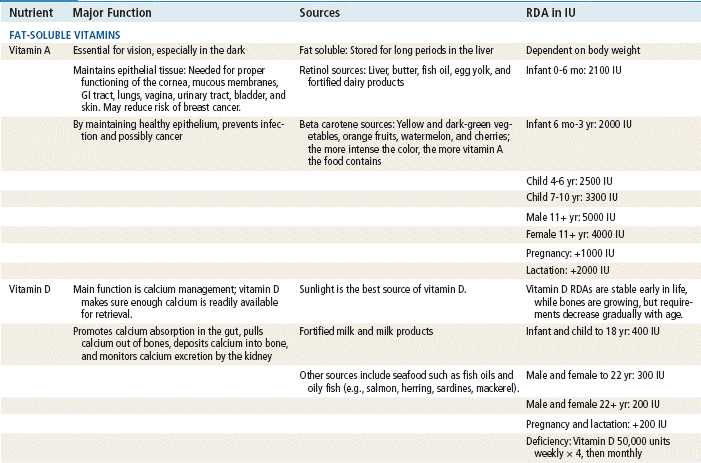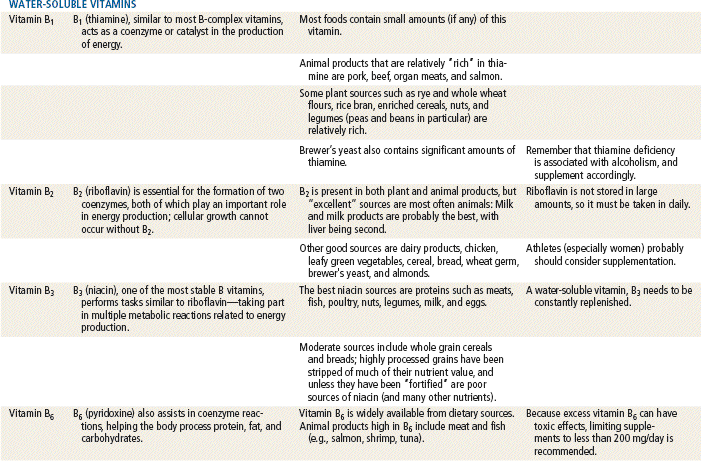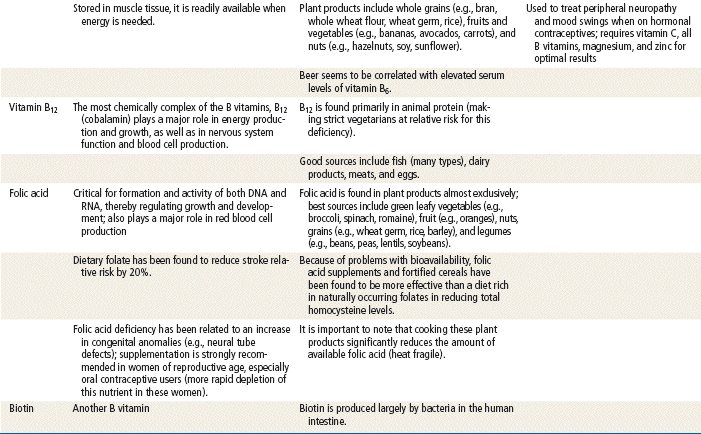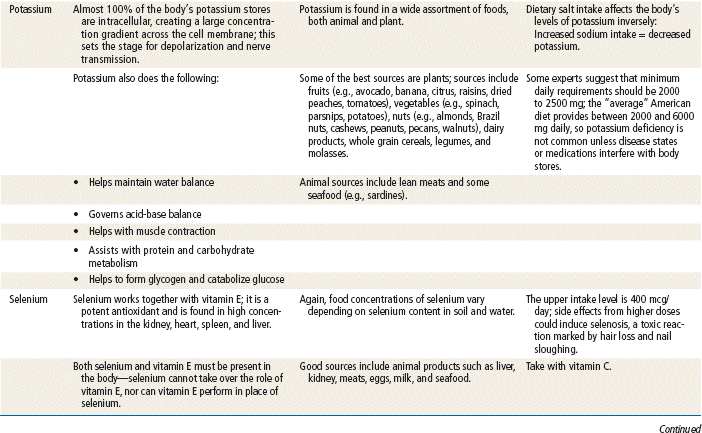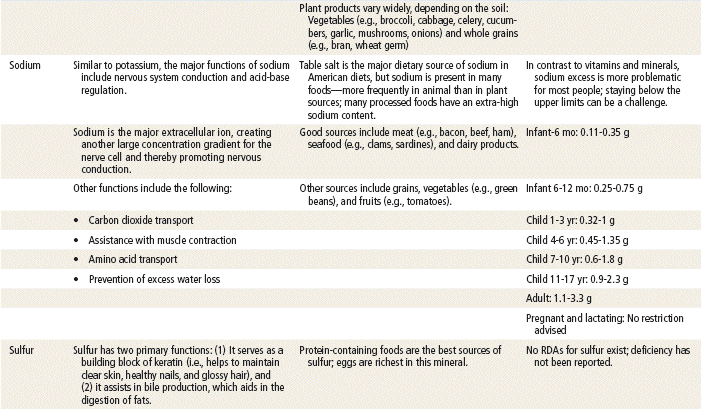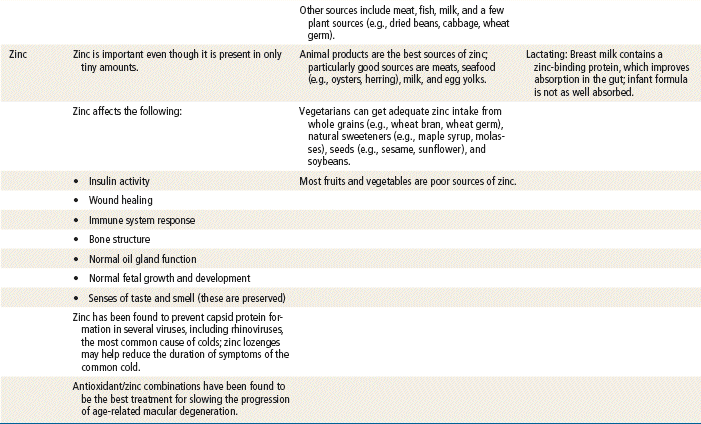http://evolve.elsevier.com/Edmunds/NP/
| Class | Generic Name | Trade Name Examples |
| Multivitamins | general multivitamins | Various OTC |
| multivitamins with minerals | Various OTC | |
| multivitamins with fluoride | Poly-Vi-Flor with Iron, Vi-Daylin/F Chewable Multivitamin Tablets, Vi-Daylin/F Multivitamin + Iron Chewable Tablets | |
| parenteral multivitamins | Various: Aquason A Parentera, Neurodep Injection, Vicam Injection | |
| prenatal vitamins (OTC) | Various: Mynatal, Natalins, Nestabs FA, Niferex-PN | |
| prenatal Rx tablets | StuartNatal Plus Tablets | |
| Other multivitamin formulations and products | anti-folic acid antagonists | Leucovorin Calcium for Injection (Rx), Leucovorin Calcium Tablets |
| antioxidant combinations | Various | |
| geriatric vitamin formulations | Various | |
| pediatric vitamin formulations | Various | |
| pediatric vitamins with fluoride | Various | |
| iron combinations | Multiple: Fumatinic, Iberet-Folic-500, Hemocyte-F, NephPlex | |
| Individual vitamins and minerals | vitamin A | Aquasol A Drops, Capsules, Injection |
| vitamin B1 (thiamine) | Thiamine HCl Injection | |
| vitamin B3 (niacin) | Nicotinic Acid Capsules, Nicobid, Nicolar, Slo-Niacin Controlled Release Tablets | |
| vitamin B6 (pyridoxine) | Pyridoxine Injection | |
| vitamin B12 | Hydrocobalamin Injection | |
| vitamin C (ascorbic acid) | Ascorbic Acid Injection | |
| Cenolate | ||
| vitamin D (calcitrol) | Calcijex Injection | |
| Rocaltrol Capsules | ||
| vitamin K | AquaMEPHYTON Injection (Rx) | |
| Mephyton Tablets | ||
| calcium | Calphron | |
| PhosLo | ||
| fluoride | Luride Drops | |
| Luride Lozi-Tabs Tablets | ||
| Pediaflor Drops | ||
| folic acid | Folvite Injection, Folic Acid Tablets | |
| phosphorus | Various: K-Phos Neutral Tablets, Neutra-Phos, Neutra-Phos K,Uro-KP Neutral | |
| zinc | Zincate |
The integrity and health of the body are maintained through nutrients. Most commonly, these nutrients come from natural sources. With a poor diet or during times of stress or illness, supplementation may be required. Vitamins and minerals then may become important components of the therapeutic regimen. Additionally, new research findings confirm the role that some of these formulations play in improving or preventing some chronic diseases. Listed in this chapter are some of the prescription and OTC formulations of multivitamins that are currently available. Also included are prescription vitamins and minerals that are currently being marketed as individual therapies. Many nonprescription vitamin preparations and many other individual vitamins and minerals are sold OTC and are not discussed in this chapter. Prescriptions may be required for costs to be covered by insurance and by Medicare.
Vitamins and minerals are by definition essential for human life, and their role in basic metabolism has been well researched (Table 73-1). However, extensive new research documents their role in health promotion and disease prevention. This is a rapidly developing field, and it is necessary for the provider to keep current with the latest research. A number of nutrients have come onto the market after varying levels of research were conducted to support their use. These include lutein, phenols, date seed, and isoflavones. Some of these may prove helpful as additional studies define their usefulness in clinical practice; however, these trials and nutrients are not discussed here. Although these vitamins and minerals are discussed separately in this text, they are most commonly taken in multivitamin combinations, often including special formulations for pediatric or geriatric persons, or supplements that help to control hot flashes for menopausal women. Vitamin supplementation in correct doses requires inclusion of other vitamins and minerals as coenzymes, and so it is not only cheaper but more effective to package these products together.
In 2002, the American Medical Association made the recommendation for the first time that all Americans should take a general multivitamin daily (AMA, 2002). This reflects the reality that many Americans fail to get all daily required nutrients through their diet, especially if they eat lots of processed and fast foods or are on weight loss diets. A study from the Department of Agriculture in late 2012 confirms that Americans fall short of USDA’s nutritional recommendations. Children and elderly people appeared to have healthier diets compared with younger and middle-aged adults. Hispanics are more likely than blacks and whites to eat healthy food. Research by registered dieticians do not agree with the AMA recommendation. They claim that most adults do not need daily vitamins or supplements. Nutritionists stress that food is the best source for nutrients and should be the first solution for nutritional deficiencies. It is clear that, a standard multivitamin supplement does not come close to making up for an unhealthy diet. It provides a dozen or so of the vitamins known to maintain health—a mere shadow of what can be obtained from eating plenty of fruits, vegetables, and whole grains. Instead, a daily multivitamin provides a sort of nutritional safety net.
Many people report being overwhelmed by all the information available about vitamins—some of it contrary to what they have always believed. One report that caused consumer concern was that among 39,000 women aged 55 to 69 in the Iowa Women’s Health Study, a slightly higher mortality rate has been found for those who took multivitamins. Researchers reported in the Archives of Internal Medicine that only calcium supplements were connected to lower relative risk of dying over 19 years of follow-up. The report concluded, “There is very little evidence showing that common dietary supplements would be beneficial in prevention of major chronic diseases.” The study showed that in women aged 55 to 69 years, several widely used dietary vitamin and mineral supplements, especially supplemental iron, may be associated with increased relative risk for death. Although many vitamin supplements did not appear to be associated with a higher relative risk for total mortality, several were, including multivitamins, vitamins B6, and folic acid, as well as the minerals iron, magnesium, zinc, and copper. The researchers concluded, “Supplements are widely used, and further studies regarding their health effects are needed. . . . Little is known about the long-term effects of multivitamin use and less commonly used supplements, such as iron and other minerals.”
Although most people get enough vitamins to avoid the classic deficiency diseases, earlier research suggests that relatively few get enough of the five key vitamins. These include folic acid and vitamins B6, B12, D, and E. A standard, store brand, RDA-level multivitamin can supply enough of these vitamins for less than $40 a year. It may be difficult to find high-quality information about vitamins, minerals, and specific products because of the influence of the food industry. Information about nutrients should be obtained from reputable sources, such as the NIH Office of Dietary Supplementation (see http://dietary-supplements.info.nih.gov/), the Institute of Medicine, or agencies and associations that do not have products to sell.
Because no uniform manufacturing rules for supplements have been put forth, some research suggests that a multivitamin may not contain what the bottle claims, could be contaminated with something from the manufacturing plant, or might include tainted ingredients—all of which suggests that products should be bought from reputable companies. The safest products have been independently reviewed and will carry a Consumer Lab seal or clearance by USP. See Box 73-1 for a list of where to get reliable information about nutritional products.
Concepts that are important to understand in interpreting much of the research on the use of vitamins and minerals have to do with relative risk vs. absolute risk. Absolute risk is risk stated without any context, so it means absolute risk is not compared to any other risks but is just the probability of something occurring. They may be expressed as percentages or as ratios. On the other hand, relative risk is a comparison between different risk levels—for example, the relative risk for a particular chronic disease if you have one risk factor compared to someone who has no risk factors. The relative risk (or risk ratio) is not the same as an increase in risk.
Nutrients included in the diet affect numerous cellular metabolic mechanisms that are common in the pathogenesis of chronic disease. Unified dietary guidelines issued jointly by six national organizations (American Heart Association, American Cancer Society, American Dietetic Association, American Academy of Pediatrics, NIH, and American Society for Clinical Nutrition) have been proposed to help reduce the relative risk of cancer, atherosclerosis, obesity, and diabetes. These unified guidelines indicate that the simplest way to achieve a healthy diet would be to include less than 10% saturated fat and no more than 30% total fat, as measured in calories; 55% of total calories should be taken in the form of carbohydrates, no more than 300 mg of cholesterol should be consumed each day, and daily salt intake should be limited to less than 6 g. Twenty-five grams of dietary fiber should also be maintained; this approach is not only cardioprotective, but it also helps to curb the tendency to eat more than is necessary by providing a feeling of fullness. The theory underlying the unified diet also suggests that total calories should be adjusted to achieve and maintain desirable weight. In June 2011, the Food Pyramid was replaced with My Plate, a depiction of the relative amounts of foods that should be eaten. This type of graphic seems to be more easily understood in guiding nutrition than previous graphic displays (http://www.cnpp.usda.gov/MyPlate.htm). The simplest way to use the guidelines would be to have all people older than 2 years do the following:
In addition, the 2010 recommendations include the following:
Special concern has been expressed about the diet of certain groups of people. Problems are associated with (1) the increasing prevalence of obesity in children and women; (2) undernourishment among the elderly; (3) osteoporosis, iron deficiency, and folic acid intake in women; and (4) the special needs of various minority populations. The American College of Obstetrics and Gynecology maintains that vitamin supplementation is not required in the pregnant woman.
Eating a well-balanced diet, implementing an exercise program, replacing saturated fats with fish and nuts, and limiting salt and alcohol intake are other key components of a healthy lifestyle. Avoid extreme diets.
The U.S. Department of Agriculture Center for Nutrition Policy and Promotion dietary guidelines for 2010 can be found at http://www.cnpp.usda.gov/DietaryGuidelines.htm.
While not a vitamin or a mineral, widespread information concerning the use of omega-3 supplements from plants and marine sources has been published. Omega-3 seems to be associated with reduced relative risk of type 2 diabetes, according to three new studies in the American Journal of Clinical Nutrition. The uses of these supplements in helping the obese to lose weight, helping lower the incidence of ventricular heart arrhythmias, and helping in lubrication of dry eyes of the elderly have all been discussed. How these agents relate to vitamins and minerals in the body is not clear. These products are available OTC.
Vitamins
Vitamins are organic materials essential for human survival that must be ingested on a regular basis because they are not synthesized by the body. Some are available in their active form; others are ingested as a “precursor” or “provitamin” that then is converted; two vitamins, vitamin K and biotin, are not ingested at all but are synthesized by bacteria inside the intestinal tract.
Thirteen essential vitamins have been identified to date, and more information about essential nutrients is being discovered every year. Only tiny quantities of vitamins are required on a daily basis, but chronic deprivation of even one vitamin will cause disease, and death can occur. The inverse is also true; some vitamins ingested in large quantities will cause illness and death. An “adequate” diet is one that includes an appropriate amount of each vitamin on a daily basis but does not include excessive amounts of any of them.
The body needs only small amounts of vitamins (that is why these are often referred to as micronutrients) because the body uses them without breaking them down, as happens to carbohydrates and other macronutrients. So far, 13 compounds have been classified as vitamins. Vitamins are classified into two types: fat soluble (will dissolve in oil) and water soluble (will dissolve in water). Vitamins A, D, E, and K—the four fat-soluble vitamins—tend to accumulate in the body. Vitamin C and the eight B vitamins—biotin, folate, niacin, pantothenic acid, riboflavin, thiamine, vitamin B6, and vitamin B12—dissolve in water, so excess amounts are excreted.
Vitamins primarily serve regulatory functions and assist in the production of energy. They are not used in the body for structural purposes and cannot be used as an energy source. Vitamins are essential but differ markedly in their absorption and potential for toxicity.
Fat-Soluble Vitamins
Fat-soluble vitamins, which include vitamins A, D, E, and K (“DEAK” for short), are found primarily in various plant and animal oils or fats. Because these vitamins are stored in our body fat, daily ingestion is not required, but adequate body levels must be maintained over the long term. When ingested, these vitamins are transported through the body by the bloodstream. For these vitamins to remain dissolved in the blood, unique carrier proteins are required for each. Some people with particular metabolic and genetic diseases are unable to synthesize carrier proteins and can have extreme vitamin deficiency states despite adequate vitamin intake.
Fat-soluble vitamins have common properties—their ability to be stored, their mode of transport, and the severity of deficiency syndromes in young children—but each vitamin is unique in its function and in its physiologic effects of deficiency and toxicity. Development of fat-soluble vitamin deficiency can be gradual and the symptoms subtle, but toxicities can present suddenly and can be devastating in their effects. Overdosage is more of a problem with fat-soluble vitamins than with water-soluble vitamins because of their ability to be stored and accumulated.
Water-Soluble Vitamins
Water-soluble vitamins include all the B vitamins (B1, B2, B3, B6, B12, folacin, biotin, and pantothenic acid) and vitamin C. With the exception of B12, these vitamins are rapidly excreted from the body because the body has no way to store them. These vitamins must be ingested on a regular basis or deficiency symptoms will quickly appear. They are not particularly toxic, however, because high levels rarely develop. These products are readily available but are destroyed by heat. Because they are water soluble, the vitamins may leach out into water used for cooking and be discarded if the consumer is not aware of how to properly store and cook them. Overdosage may occur when large quantities are taken chronically and exceed the body’s ability to excrete them.
The definition of a healthy daily intake of B vitamins is not set in stone and is likely to change over the next few years as data from ongoing randomized trials are evaluated. Because only a fraction of U.S. adults currently get the recommended daily intake of B vitamins through diet alone, use of a multivitamin supplement is becoming increasingly important.
Minerals
Minerals are inorganic substances present in the body that work in combination with enzymes, hormones, and vitamins. Most human minerals are found in the skeleton and make up about 4% of total body weight. Calcium and phosphorus are by far the predominant minerals in the body.
Minerals, similar to vitamins, are essential for body function but are present in much smaller amounts. Both acute and chronic mineral deficiencies, as well as toxicities, can occur, because even though the daily intake may vary enormously, the average adult will consistently excrete several grams of minerals every day.
Minerals are classified as major or trace. Major minerals (e.g., calcium, phosphorus, magnesium, potassium, sodium, and chloride) must account for at least 0.01% of body weight. Trace minerals (e.g., arsenic, chromium, cobalt, copper, fluoride, iodine, iron, manganese, molybdenum, nickel, selenium, silicon, tin, vanadium, and zinc) fall below 0.01% but are still measurable and have metabolic impact, although the exact biologic significance of some of these trace minerals remains a mystery. The label applied to a particular mineral (“major” or “trace”) does not imply significance; excess or deficiency of any of the minerals can be devastating.
Minerals are found in a variety of states as free ions or bound to many different substances (such as iron to hemoglobin or cobalt to vitamin B12). This variety allows minerals to perform many different biologic roles within the body.
How to Monitor
Numerous tools are now available that provide noninvasive monitoring of dietary patterns or serve as computerized nutritional assessment tools. MyPyramid Tracker is an excellent resource for clinicians and laypersons to use in monitoring nutritional intake. Many of the commercial weight loss programs have a website at which the individual can complete a daily food and exercise log and receive feedback about dietary intake.
Blood studies to determine nutrient levels generally are not indicated. If a person presents with a particular set of physical symptoms that seem to be related to nutrient deficiencies or toxicities, blood and hair studies by specialists may provide the answers.
Patient Variables
Daily requirements of vitamins and minerals vary from person to person and with age, sex, physiologic state (e.g., pregnancy), and physical activity. The development of a completely comprehensive list is impossible, so the Food and Nutrition Board of the National Academy of Sciences, National Research Council, developed a list of RDAs that was first published in 1943 and is updated every few years. This RDA list was not intended to be comprehensive but attempts to define what amounts of each vitamin and mineral would be appropriate to meet the needs of normal, healthy people. In fact, the RDAs are deliberately set higher than the requirements for an “average” person, to compensate for dietary deficiencies or to offer a “safety zone.”
A healthy individual who conscientiously adheres to the RDA will take in adequate amounts of essential vitamins and minerals. However, the RDA may be excessive or inadequate for a person in poor health or for someone who has a metabolic or genetic disorder. The U.S. Preventive Task Force is a good resource for current recommendations on vitamin and mineral supplements.
Geriatrics
Elderly people may have highly variable nutritional needs depending on their state of health. Metabolic changes have slowed the digestive rate, increased the fat-to-muscle ratio, and decreased liver and renal functions; all of these events have an impact on digestion, absorption, and excretion of vitamins and minerals. Use of medication also can have a significant impact on absorption and utilization of nutrients.
Dietary deficiencies in the elderly can occur for many reasons—for example, because older persons may not eat sufficient food, may not eat the correct foods, or may not eat an adequate variety of foods. Vitamin B12 deficiency may result from decreased acidity of the stomach. The signs of vitamin deficiency may be subtle but always should be considered; for example, thiamine deficiency (associated with alcohol abuse) can cause Wernicke’s encephalopathy or organic amnestic syndrome, folic acid deficiency is associated with dementia, and vitamin B12 deficiency can result in psychologic changes and peripheral neuropathy. Vitamin D deficiency is not uncommon among the elderly, especially in nursing home residents or others who do not get out in the sun. A vitamin D deficiency can contribute to osteoporosis.
Pediatrics
Pediatric RDAs for various vitamins and minerals vary widely; age and body weight are significant factors, and careful attention should be paid to children’s diets throughout the growing years. Nutrient deficiency states are always quickly seen and often are more devastating in children than in adults. Some deficiencies can have lifelong effects as well; for example, vitamin D deficiency causes abnormalities in bone ossification, causing bones to become soft and bend in a disease called rickets. Vitamin D therapy will stop further damage but will not correct many existing bone deformities.
As children grow, their need for supplementation changes. Breastfed infants get almost all the nutrients they need from their mother. The only supplements these babies may need are fluoride (which is present in only small amounts in breast milk) and an iron supplement after 4 to 6 months of age. Bottle-fed infants receiving infant formula are receiving the RDA through the formula. Consider the use of iron-fortified formula after age 4 months.
As they start to eat solid foods, however, many children develop strong food preferences, and parents can struggle to maintain a balanced diet. Balance over time is the important point to remember. Not every meal has to include every nutrient; ensuring a balance for the day is sufficient. Caution parents to avoid food conflicts by frequently offering small portions of foods from many sources. Vitamin supplementation is not necessary for a child who is willing to eat from many food groups, but it may be helpful in the child who eats only a small variety of foods.
A study published online by the Journal of Endocrinology and Metabolism revealed that children who followed a diet with limited fat content and high levels of dietary fiber had better fasting blood glucose levels and lower blood pressure and very low-density lipoprotein levels at ages 25 to 29 compared with those in the control group. Metabolic syndrome also was uncommon in the dietary-intervention group, the researchers found.
Pregnancy and Lactation
In general, almost all vitamin and mineral RDAs increase during pregnancy, to support the increase in metabolic rate and the demands of a growing fetus. These nutritional needs, with the exception of iron, can be met by most women through diet. Iron requirements during pregnancy are nearly impossible to meet by diet alone, and iron deficiency anemia may result. Folic acid supplementation is being recognized increasingly as an essential pregnancy nutrient, and many physicians are recommending the use of iron and folic acid supplements by all pregnant women.
One potential problem in pregnancy is vitamin and/or mineral toxicity. Nutrients that are particularly harmful to a developing fetus if provided in excess (10 or more times the RDA) include iron, zinc, selenium, and vitamins A, B6, C, and D. Although some vitamins taken in excess just pass through the system and are excreted in the urine, other vitamins may be stored in tissues, and toxicity may develop. When megadoses of vitamins such as A and C are consistently taken, the body develops a tolerance for the higher doses.
Gender
Men’s nutritional needs remain relatively stable from late adolescence into old age. With aging, illness, and injury, dietary needs must be reassessed, and supplementation might be considered. Elderly men (>80 years) are at relative risk for osteoporosis. Adequate calcium intake is essential in elderly men and women.
Women’s needs vary widely throughout their lifetime. Until adolescence, children’s needs are essentially the same, and a gradual increase in RDA is noted for most nutrients. During adolescence, however, women’s dietary needs undergo striking changes.
With the onset of menses, dietary iron needs increase. Many women do not take in adequate amounts of dietary iron to compensate for monthly blood loss. This need decreases with the use of hormonal contraception. Adolescents and young women lower their relative risk of iron deficiency anemia when they use hormonal contraception.
It is certainly possible for an individual’s diet to provide sufficient iron, but because many women diet to keep their weight down and men may engage in excessive exercise, and because many individuals do not develop good food habits (or do not learn them during adolescence), many American diets are inadequate, and iron supplementation should be considered.
Folic acid supplementation (400 mcg) should be taken by all women of reproductive age. A deficiency in this B vitamin has been shown to be related to an increase in neural tube defects in the developing fetus.
Appropriate calcium intake is a significant problem for American women. Chronic calcium deficiency often starts in young women and worsens with age. As adolescence begins, many women stop drinking milk. Many women become deficient in calcium just when they need it most for pregnancy, lactation, and menopause. Bone loss accelerates during the first 5 to 10 years after menopause and if not stopped can lead to devastating consequences. In a study on white women, it was estimated that 25% of women older than age 70 and 50% of those over age 80 will show evidence of vertebral fracture. By the age of 90, 33% of all white women will have sustained a hip fracture, and many of these women will die as a direct result of complications related to the fracture. Comparable data are not available for women of other races. Initiation of calcium supplementation by age 35 has been proposed by many scientists; it should continue through menopause and should be added as an adjunct to bisphosphonate treatment for osteopenia or osteoporosis (see Chapter 39).
Vitamin D is another critical bone-building nutrient that many women lack when they need it most—as they age. Vitamin D promotes calcium absorption, and one without the other is useless. Taking a calcium supplement without paying attention to vitamin D does not help bones. Many women become deficient in vitamin D because they stop drinking fortified milk and do not spend sufficient time outside to absorb UV radiation to make vitamin D. Many women, because they are worried about the relative risks of skin cancer, cover all exposed skin if they do go outside, again blocking vitamin D absorption. Many research studies have suggested clinical problems linked to low Vitamin D levels but the quality of many studies is problematic at this time.
Patient Education
All individuals should be counseled regarding their nutritional needs. Parents should be aware of the needs of growing children and should learn how to manage their children’s diets. Young teenagers should be told about the importance of balance in the diet. This is particularly important for youth engaged in vigorous sports or types of dance such as wrestling or ballet when forced weight loss may be an issue, or when they are attempting to lose or gain weight. Older adolescents should be aware of typical “pitfalls,” which include decreased calcium intake, increased alcohol and soda consumption, and fad and weight reduction diets. They also should be informed about the hazards of vitamin and mineral toxicities. Pregnant and lactating women, as well as young mothers, require frequent nutritional “updates” as they progress through the childbearing years. Older women should be encouraged to supplement their diet with calcium and vitamin D to prevent osteoporosis. Older people of both genders should receive periodic reminders about the importance of balance in the diet and, together with their care provider, should consider appropriate nutritional supplementation when illness or injury occurs.
For many years, RDAs were published. In 1997, dietary reference intakes were published as well. Since 2006, these terms have been further refined to include estimated average requirement, adequate intake, and tolerable upper intake level. These different levels are listed in common nutrition resources and in many pharmacology texts. Because of the overlap in these terms, for the purposes of this text, the term RDA will be used and will be specified for specific age groups and genders. RDAs are also available in small amounts for choline and chloride. These elements are not discussed in this text.
Controversy Over Antioxidants
The hypothesis that antioxidant vitamins might reduce the relative risk of many degenerative diseases is based on a large body of basic and human epidemiologic research. However this hypothesis is unsupported by randomized, placebo-controlled trials. One of the most consistent findings in dietary research is that those who consume larger quantities of fruits and vegetables have lower rates of heart disease, stroke, and cancer. Attention has been focused recently on the antioxidant content of fruits and vegetables as a possible explanation for their apparent protective effects.
Increasing evidence suggests that free radical reactions are involved in early or later stages of development of human disease; it is therefore of particular importance for researchers to explore whether vitamin E and other antioxidants found in the human diet may be capable of lowering the incidence of disease. Low levels of antioxidants, which increase free radical activity, are clearly associated with an increased relative risk of these diseases. Put simply, the proposition is that if human diets are improved by an increase in the quantity of antioxidants included in them, it might be possible to use this approach to reduce the incidence of numerous degenerative diseases.
Antioxidant vitamins, which include beta carotene (provitamin A), vitamin E, and vitamin C, are hypothesized to decrease cancer relative risk by preventing tissue damage by trapping organic free radicals and/or deactivating excited oxygen molecules—a byproduct of many metabolic functions. These micronutrients may be reduced by smoking and passive smoking.
Over the past decade, extensive studies on the health effects of antioxidants have been conducted, many with inconclusive findings. The largest analysis of data on antioxidant vitamins ever conducted, which was published by Bjelakovic et al in 2007, shows that on the whole, antioxidant vitamins confer no health benefits. In fact, beta carotene, vitamin A, and vitamin E may actually increase mortality. More recent studies suggest there may be some utility in antioxidants. In a 2011 study of 2264 U.S. women diagnosed with early-stage breast cancer, those who took supplements of vitamin C or vitamin E at least 6 days a week had a lower relative risk of cancer recurrence; however, the reduction in absolute risk was very low. More studies should be undertaken to evaluate the use of excessive exogenous antioxidants. It appears they may actually impair endogenous antioxidant reserves, thus impairing natural processes, and actually contribute to harm.
Stay updated, free articles. Join our Telegram channel

Full access? Get Clinical Tree


